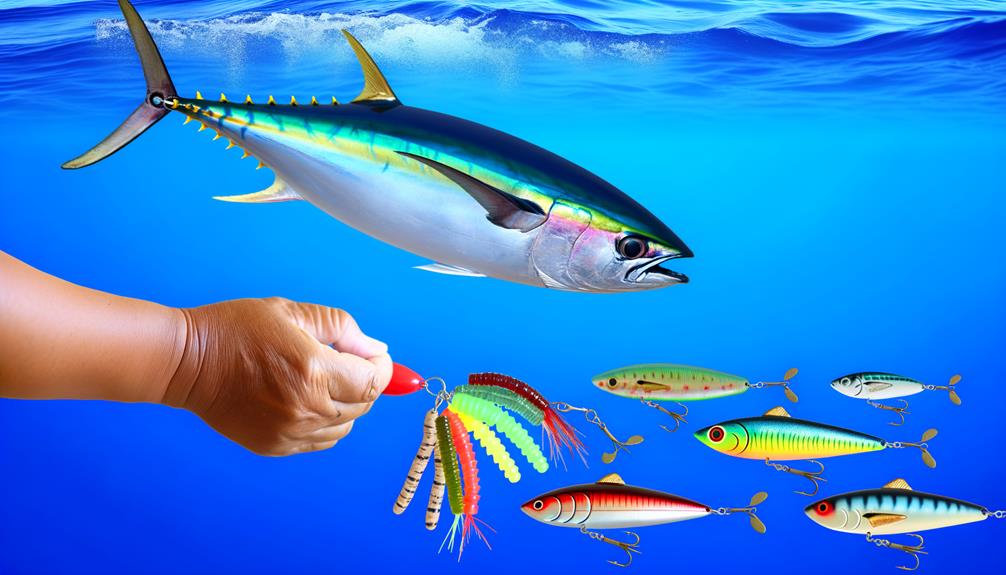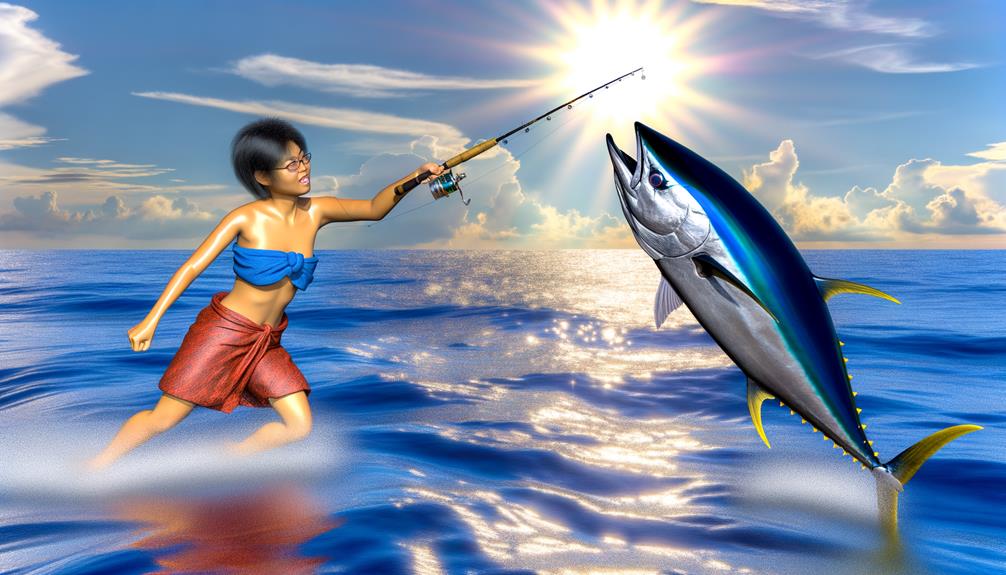Have you ever pondered the art of capturing the elusive bluefin tuna? It's more than just a matter of casting a line and hoping for the best. This sport requires strategy, patience, and a keen understanding of this magnificent creature's habits and habitats.
You'll need the right gear, the perfect bait, and the ability to identify prime fishing locations. But that's just scratching the surface. There are secrets, tips, and tricks of the trade that can significantly increase your chances of success.
Ready to discover what they are?
Key Takeaways
- Bluefin tuna are highly migratory and travel long distances in search of food and suitable spawning grounds.
- Understanding the migration patterns and habitats of bluefin tuna is crucial for locating them.
- Choosing the right fishing gear, including a strong fishing rod and quality fishing line, is essential for successfully catching bluefin tuna.
- Using suitable bait, such as natural baits like mackerel or squid, can increase the chances of attracting bluefin tuna.
Understanding Bluefin Tuna Behavior
To truly grasp the intricacies of catching Bluefin tuna, it's essential to understand their migratory and feeding patterns, their sensitivity to water temperatures, and their unique deep-diving and schooling behaviors.
Bluefin tuna are highly migratory, traveling thousands of miles in search of food and suitable spawning grounds. Recognizing these patterns gives you a good shot at being in the right place at the right time to catch Bluefin tuna.
These magnificent creatures are known for their deep diving behavior, often plunging to depths of over 3,000 feet. This behavior is vital in understanding how to effectively target them. They're sensitive to water temperature and tend to follow the migration patterns of their preferred water temperatures. Keeping tabs on water temperature variations can help you identify potential hotspots.
Bluefin are opportunistic feeders, preying on a variety of small fish, squid, and crustaceans. Understanding their diet can facilitate more effective bait selection. Furthermore, they exhibit schooling behavior, often traveling and feeding in large, coordinated groups. Locating these schools can significantly increase your chances of a successful catch.
With this understanding of Bluefin tuna behavior, you're one step closer to mastering the art of catching these incredible fish.
Choosing the Right Fishing Gear
When it comes to catching Bluefin Tuna, equipping yourself with the right fishing gear is crucial. You'll need to select a fishing rod that's up to the challenge, ensuring it's capable of withstanding the strength and speed of these powerful fish.
Additionally, the quality and strength of your line, as well as the suitability of your bait, can significantly impact your success on the water.
Selecting Proper Fishing Rods
Choosing the right fishing gear, specifically a suitable rod, is crucial and relies on the type of fishing you plan on doing, the species, size, and weight of the fish you aim to catch.
Whether you're fly fishing, trolling, or casting, the rod's power and action must align with your technique and the strength needed to handle your target fish, like the hefty Bluefin tuna.
Seek a rod made of fiberglass, graphite, or a blend, considering factors such as durability, flexibility, and weight. When using live bait, a medium-heavy rod with moderate action is typically a good choice.
Don't hesitate to ask experienced anglers or gear experts for advice. Remember, proper gear selection is key to a successful 4cast.
Importance of Quality Lines
Just as selecting the right rod is essential, you shouldn't overlook the importance of using quality lines, especially when you're up against a formidable opponent like the Bluefin tuna. Their size and diet mean they're powerful fighters, and subpar lines will snap under the strain. Good quality lines can withstand their force, ensuring a secure hookset when you're battling these beasts.
| Bluefin Tuna Fact | Why Quality Line Matters |
|---|---|
| Bluefin tuna size | Large, powerful fish that can easily snap low-quality lines |
| Bluefin tuna diet | Heavy diet leads to strong, feisty fish that can put up a good fight |
| Bluefin tuna fishing regulations | Regulations mean you need to land the fish quickly and efficiently |
Suitable Bait for Bluefin
Navigating the vast selection of baits and fishing gear for Bluefin tuna can be daunting, but knowing what's suitable can make a big difference in your success rate.
Understanding the bluefin diet is vital. They're partial to natural baits like mackerel, squid, or sardines. However, there are alternative bait options such as artificial lures like poppers, jerkbaits, or stick baits that mimic surface feeding behaviors, especially useful when catching bluefin from shore.
Opt for heavy-duty rods and reels to handle their strength and speed. High-quality fishing line with a minimum pound test of 60, swivels, and leaders are essential to prevent line breakage and twists, ensuring a secure hookset.
You're now more prepared to catch that elusive bluefin.
Identifying Prime Bluefin Locations
Now, let's turn our attention to finding the best spots for bluefin tuna.
You'll need to understand their migration patterns, know the habitats they prefer, and be aware of seasonal hotspots.
With this knowledge, you'll be better equipped to pinpoint where these elusive, prized fish are likely to be found.
Understanding Bluefin Migration Patterns
Ever wonder how to find the best spots for encountering bluefin tuna during their migration? Understanding bluefin tuna migration routes is key. Factors influencing migration patterns include water temperatures, prey availability, and breeding grounds. By monitoring these factors, you can identify prime locations.
Utilize tracking technology for bluefin tuna, like satellite tagging data and marine biologist research. These tools provide insights into movement patterns and habitats. Local knowledge from experienced fishermen and charter captains is also invaluable.
| Key Factors for Migration | Tools for Tracking |
|---|---|
| Water Temperatures | Satellite Tagging |
| Prey Availability | Research |
| Breeding Grounds | Local Knowledge |
| Seasonal Patterns | Charter Captains |
Ideal Bluefin Tuna Habitats
To increase your chances of catching bluefin tuna, you'll want to identify and target habitats where these magnificent fish thrive. Understanding the nature of these habitats is key in locating and successfully catching these sought-after species. Here are five key points to consider:
- Seek areas rich in baitfish such as sardines and mackerel
- Look for underwater structures like seamounts, canyons, and reefs
- Monitor water temperature, as bluefin prefer temperatures between 59°F and 72°F
- Areas with strong currents are prime bluefin habitats
- Converging warm and cold water currents create ideal feeding grounds
Seasonal Bluefin Hotspots
Having identified the key habitats that bluefin tuna prefer, let's pinpoint specific locations and times of the year that are renowned for their bluefin tuna populations. Understanding migration patterns is key to knowing when to set your line. Let's take a look at a few hotspots:
| Location | Ideal Fishing Times |
|---|---|
| Gulf of Mexico | Summer |
| Cape Cod | Late Summer – Early Fall |
| California Coast | Late Summer – Fall |
| Prince Edward Island | Summer |
Selecting suitable bait is essential, but knowing where and when to fish is half the battle won. Whether you're in the Gulf of Mexico or off Cape Cod, align your fishing trips with these times to increase your success.
Best Times for Bluefin Tuna Fishing
If you're keen on catching bluefin tuna, remember that early morning and late afternoon are your best bets when these fish are actively feeding near the surface. Understanding feeding habits is key. You'll find that targeting larger bluefin during these times can yield impressive catches.
Weather conditions also play a crucial role. Bluefin are more likely to feed on the surface during overcast or foggy conditions. So, don't shy away from fishing during different weather conditions.
To maximize your chances, consider the following:
- Look for temperature breaks and strong currents. These conditions attract bluefin tuna.
- Spring and fall are prime seasons. Bluefin tuna are more abundant and easier to catch during these times.
- Keep an eye on the moon phase. Bluefin tuna tend to be more active during the full moon phase.
- Warmer water temperatures, between 65-70°F, are ideal for bluefin tuna.
- Lastly, don't overlook the power of observation. Watch for birds diving; they can indicate where bluefin are feeding.
Selecting the Perfect Bait

Choosing the perfect bait for Bluefin Tuna is as much an art as it's a science. You'll find live bait like sardines or mackerel could be irresistible to these mighty fish. But don't shy away from trying different jigs or burn baits.
Choosing Appropriate Tuna Bait
When it comes to enticing bluefin tuna, you'll find that live bait like sardines or mackerel can be highly effective, especially for chumming to attract these fish to your boat. Understanding tuna behavior, selecting fishing gear, and mastering effective bait presentation techniques are critical to your success.
Consider these options:
- Knife jigs (e.g., 240 gram and 200 gram options by Mustad) rigged with assist hooks for better hooking potential.
- Poppers (150s and 120s) when tuna are actively feeding on the surface.
- Burn baits, including colt snipers, jerkbaits, and stickbaits, when cast and retrieved in varied ways.
- Experiment with different baits and lures to discover your optimal catch method.
Choosing the right bait is a science, and it requires patience, practice, and precision.
Effective Bait Presentation Techniques
To consistently lure in bluefin tuna, it's crucial you understand their diet and select baits that closely mimic their natural prey. Freshness is key; opt for fresh bait, which emits a strong scent and demonstrates realistic movement in the water. Pay attention to bait size and shape – aim for a match with the tuna's natural prey. This will significantly heighten your chances of a successful hook-up.
Your bait presentation must be impeccable. Be adept at adjusting bait depth to mirror the tuna's feeding behavior. The live bait advantages are noteworthy; their natural movement and vibrancy can outshine other lures.
Techniques for Casting Your Line
Mastering the right casting techniques can significantly improve your chances of catching bluefin tuna, as it's not just about strength, but also precision, understanding of water conditions, and the effective use of wind. Understanding casting techniques involves not only the physical act of casting, but also the mental aspect of knowing when and where to cast.
When you're out on the water, adjusting to water conditions is a must. Wind, current, and wave action all influence the behavior of the bluefin, and thus, your approach.
Speaking of the wind, utilizing wind advantage is crucial. A strong wind can help carry your line further, while a gentle breeze can offer just enough disturbance to the water to pique a tuna's interest.
Consider the following tips to enhance your casting skills:
- Practice casting to achieve distance and accuracy.
- Learn to adjust your cast strength and angle to match water conditions.
- Cast with or against the wind for optimal results.
- Experiment with different bait presentation methods.
- Aim your cast to areas where bluefin tuna are known to frequent.
Applying these techniques will make you part of an elite group of anglers who successfully catch the elusive bluefin tuna.
The Art of Reeling In

Having honed your casting skills, it's time you learn how to reel in that mighty bluefin tuna effectively, a task that requires a unique blend of strength, finesse, and adaptability. Successful reeling is a culmination of appropriate reeling techniques, efficient battling strategies, and timely tackle adjustments.
To help you understand better, let's look at a quick table:
| Technique | Strategy | Tackle Adjustment |
|---|---|---|
| Smooth Reeling | Maintain Tension | Adjust Drag |
| Pump-and-Reel | Adapt to Fish's Movements | Keep Rod Tip Up |
| Control Over Fish | Gain Line | Prevent Line Breakage |
| Steady Movements | Avoid Jerking | Match Power of Fish |
Reeling smoothly and steadily prevents jerking that could lose you the fish. The pump-and-reel technique helps gain line when the tuna pulls hard against the drag. Adjusting your drag to match the fish's power prevents line breakage.
Keep in mind, the art of reeling in a bluefin isn't static. You must adapt to the fish's movements and maintain control by adjusting your technique. Remember, patience is your ally. With practice and perseverance, you'll master this art, making you a part of the elite league of bluefin tuna anglers.
Safely Handling Your Catch
Once you've successfully reeled in a bluefin tuna, it's crucial you handle your catch safely and effectively to maintain its quality and prevent potential injury. The excitement of the catch can easily lead to overlooking the importance of proper handling techniques, but they're key to ensuring fish safety and preventing damage to the catch.
So, what're these techniques?
- Use a gaff or tail rope to secure your tuna once it's on board. This keeps you and the fish safe.
- Stay clear of the fish's sharp fins and tail. These can cause serious injuries if not treated with respect.
- Handle the fish's body with a wet towel or gloves. This protects the tuna's slime layer and scale integrity.
- Keep your catch in the shade, away from direct sunlight. Sun can degrade the quality of the fish's flesh.
- Chill your tuna quickly in a fish bag or ice slurry. Rapid cooling preserves the flavor and texture of the meat.
Guidelines for Bluefin Tuna Release

When it comes to releasing a bluefin tuna, it's crucial you follow a few key guidelines to ensure the fish's survival and minimize its stress and injury. Understanding release techniques can be the difference between life and death for these majestic creatures.
Start by using non-offset circle hooks. They significantly reduce injury during the hooking process. This is one of the fundamental catch and release methods that promotes conservation practices.
Minimizing fight time to exhaustion is also essential. Apply consistent pressure and avoid overexerting the fish. This is a delicate balance that requires skill and experience, but you'll get the hang of it.
Always aim to keep the bluefin in the water. This aids in the release process and reduces stress. If you must handle the fish, use de-hooking tools to safely remove the hook and cut handling time.
Essential Tips for Bluefin Tuna Fishing
Building on your knowledge of safe catch and release practices, it's now time to boost your bluefin tuna fishing skills with some essential tips, ensuring not just an exciting catch, but a humane one too.
Understanding the underwater camouflage of bluefin tuna is crucial. They're attracted to the color and movement of bait, but you must also account for the water's light and clarity. Bait should mimic their natural prey, blending in yet standing out just enough to catch their attention.
Master trolling techniques. Set your boat's speed and direction to mimic the movement of bait fish. Use multiple lines at varying depths to cover more area.
Fishing regulations need to be strictly adhered to. Not only does this protect the bluefin population, but it also safeguards you against legal repercussions.
Here are some additional tips to remember:
- Understand bluefin tuna migration patterns and locations
- Set up your bait effectively
- Drift your bait to increase chances of a catch
- Hook the bluefin correctly to secure a successful catch
- Manage the catch properly for a safe, humane release
These tips, along with your patience and perseverance, will go a long way in enhancing your bluefin tuna fishing experience.
Frequently Asked Questions
What Is the Best Way to Catch Bluefin Tuna?
Understanding tuna seasons, gear selection, and bluefin habits is crucial. You'll need top-notch gear, knowledge of their migratory patterns, and timing your fishing trips with their preferred seasons to successfully catch these elusive fish.
What Bait Do You Use for Bluefin Tuna?
You'll want to use live bait like sardines or mackerel. Bait preference can change with seasonal variations, so it's crucial to observe and adapt. Always ensure your bait's freshness for the best results.
Are Bluefin Tuna Hard to Catch?
Yes, bluefin tuna are challenging to catch. Their migration patterns and remarkable strength make them elusive. It's crucial to respect conservation efforts, making sure you're not depleting their numbers while enjoying the thrill of the chase.
How Long Does It Take to Catch a Bluefin Tuna?
Catching a bluefin tuna, with their seasonal migrations, can take minutes to hours. You'll need patience, durable equipment, and an understanding of seasonal variations. It's hard, but the sense of achievement makes it worthwhile.
Conclusion
So, are you ready to reel in the big one?
Remember, understanding bluefin behavior, using the right gear, and choosing the perfect bait are crucial.
Timing and location are also key factors.
Ensure you handle your catch safely and follow the guidelines for release.
With these expert tips and techniques, you're well on your way to catching bluefin tuna.
Happy fishing!
